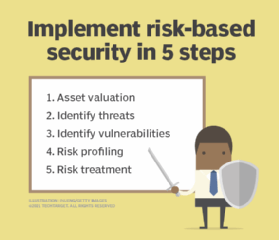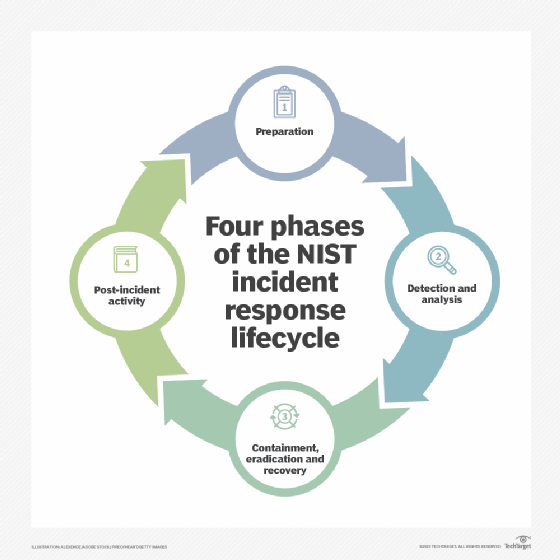What is OPSEC (operations security)?
OPSEC (operations security) is an analytical process that military, law enforcement, government and private organizations use to prevent sensitive or proprietary information from being accessed inappropriately. The OPSEC process identifies the organization's critical information, analyzes threats to that information, determines potential vulnerabilities, assesses the level of risk to each vulnerability and develops the countermeasures needed to protect the information.
The OPSEC approach to security emphasizes the importance of adopting the adversary's perspective. Security managers, IT managers and other professionals involved in the process should view their operations and systems through the eyes of those who represent a potential threat. These insights inform how they protect what is known as critical information.
Critical information can include any details whose exposure could lead to compromised data or disrupted operations. The exact nature of the information depends on the type of organization and its circumstances. To protect critical information, OPSEC accounts for any activity or process that could potentially compromise the information, regardless of how it is defined by the organization. The OPSEC analysis might target social media activity, an individual's schedule, inadequate security safeguards or any number of other possibilities.
History of operations security
OPSEC was developed as a methodology during the Vietnam War when U.S. Navy Admiral Ulysses S. Grant Sharp, commander in chief of the U.S. Pacific Command, established the Purple Dragon team to find out how the enemy obtained information on military operations before they occurred. The main goal of this effort was to prevent adversaries or potential adversaries from discovering critical data that could compromise an operation's success or the safety of the people carrying it out.
The OPSEC approach proved so effective that it was formally adopted by the entire U.S. military and eventually spread to other parts of the federal government, including agencies within the Department of Defense (DOD). In January 1988, the White House issued National Security Decision Directive 298 (NSDD-298), which required all U.S. government departments and agencies to adopt the OPSEC approach.
More recently, in January 2021, the White House issued National Security Presidential Memorandum 28 (NSPM-28) to help further the commitment to OPSEC within the government. NSPM-28 dedicated new resources to the OPSEC program, including training and implementation aids. It also established the National Operations Security Program office within the National Counterintelligence and Security Center, which is under the Office of the Director of National Intelligence.
As information management and protection have become increasingly important to the private sector, OPSEC measures are now being incorporated into business operations. OPSEC provides organizations of all types and sizes with a comprehensive yet flexible strategy for protecting sensitive resources.
Why is OPSEC important?
OPSEC encourages managers and other professionals to view operations and projects from the outside in -- that is, from the perspective of competitors or enemies. The primary goal of the OPSEC process is to proactively identify potential vulnerabilities and address them before critical information is exposed. If an organization can extract its own information while acting as an outsider, an outside adversary can likely do the same.
Regular risk assessments are an important part of an OPSEC strategy. An organization must be able to identify vulnerabilities and threats before they turn into real issues. OPSEC forces organizations to do in-depth analyses of their operations and determine where sensitive data might be breached. By looking at their operations from an adversary's perspective, OPSEC teams can spot vulnerabilities that traditional approaches to security might miss. In this way, they can implement more extensive strategies based on a more comprehensive understanding of the potential risks.
The OPSEC process provides organizations with a structure for assessing and fine-tuning their internal security processes, whether they apply to IT infrastructure or human resources. Not only can this help to streamline operations, but it can also lead to more effective and comprehensive protection. OPSEC goes beyond traditional information security safeguards to ensure that data protections account for both physical operations and human behavior, thus minimizing the risk of inadvertently exposing critical information.
To this end, OPSEC is concerned with all aspects of security, from network protections to the online footprint of the organization's employees. OPSEC examines the various factors that go into protecting critical information and what it takes to prevent its unplanned exposure. If this information is exposed, an organization could face an increased risk to its future operations and activities.
An effective OPSEC strategy makes it less likely that the people and systems within the organization unintentionally expose its critical information. With such a strategy in place, the organization knows what measures it needs to take to reduce its threat footprint and protect its critical information.
What are the 5 steps in OPSEC?
In April 1990, not long after the White House issued NSDD-298, the Interagency OPSEC Support Staff published a monograph that provided background information about OPSEC and discussed the provisions of the NSDD, which formalized the OPSEC program. The monograph described OPSEC as a five-step process: identification of critical information, analysis of threats, analysis of vulnerabilities, assessment of risks and application of countermeasures.
Today, many organizations follow the same process, using some variation of the following five steps to meet their specific requirements:

- Identify critical information. The first step is to determine which critical information would cause the most harm if an adversary obtained it. This includes intellectual property, financial statements, credit card data, product research and personally identifiable information, which might come from employees, customers, clients, patients or other sources.
- Analyze threats. The next step is to identify who is a threat to the organization's critical information. There might be numerous adversaries who target different information. For example, a company that sells software products should consider any competitors or hackers who might target its source code.
- Analyze vulnerabilities. In this stage, the organization examines its operations and tries to identify potential vulnerabilities. The analysis not only includes the systems in place for protecting critical information, but also any operations, routines or behavior that could potentially compromise that information.
- Assess risks. The next step is to determine the threat level associated with each of the identified vulnerabilities. The organization should rank the risks based on factors such as the likelihood of a specific type of attack or how damaging it would be to operations. Higher-risk events have a more pressing need for countermeasures.
- Apply appropriate countermeasures. The last step involves planning and deploying countermeasures that will help mitigate the risks. The best place to start is with the risks that represent the biggest threat to operations. Potential security improvements might include hardware upgrades, increased training or a new information governance strategy.
Operations security best practices
An organization that plans to implement an end-to-end operations security program should consider the following best practices:
- Deploy a change management strategy. Organizations should implement change management processes that employees should follow whenever adjustments are made to the network and its resources.
- Restrict device access. No devices should be permitted to access network resources beyond what is absolutely necessary to carry out specific operations, and all access should be carefully controlled and monitored.
- Implement the principle of least privilege. IT should adhere to the principle of least privilege, which ensures that systems, applications, processes and users have only the minimum access needed to perform their jobs or functions.
- Deploy dual control. Organizations should ensure that the teams and individuals responsible for maintaining the corporate network are separate from the teams and individuals responsible for setting security policies. This approach guards against conflicts of interest and other issues.
- Implement automation. People are typically the weakest links when it comes to enterprise security. Humans make errors -- inadvertently or purposefully -- causing data to end up in the wrong hands. They often overlook or forget important details and bypass critical processes. Automation can help address many of these issues.
- Craft a disaster recovery plan. A key part of any information security defense is to plan for disaster and implement a strong incident response plan. Even the most fully functional OPSEC program must be accompanied by a disaster plan that identifies risks and details how a company will respond to disruptive events, like cyberattacks, and limit potential damages.

OPSEC training
The Center for Development of Security Excellence (CDSE), which is part of the DOD's Defense Counterintelligence and Security Agency, offers a web-based course on OPSEC. The course, GS130.16, is designed for military personnel, DOD employees and contractors, as well as other U.S. government employees and affiliates.
The CDSE course offers OPSEC awareness training, along with details about protecting personal information and unclassified information related to operations. The course addresses the following learning objectives:
- Define operations security.
- Identify critical information.
- Know OPSEC's five steps.
- Recognize potential threats and how they might lead an adversary to uncover sensitive information.
- Apply appropriate countermeasures to protect critical data.
Participants who take only an occasional CDSE course should consider taking the GS130.16 course at the Security Awareness Hub website, which does not require them to register. After the course, participants receive a certificate of completion, although CDSE does not maintain records of those who complete the course.
CDSE training is also available through its Security Training, Education and Professionalization Portal (STEPP), a learning management system for the center's security courses. CDSE recommends the portal for students who take CDSE courses regularly. The STEPP system tracks course completion and provides a transcript that can then be used to request American Council on Education credits or continuing education units.
OPSEC strategies and processes are interrelated with the work of SecOps teams. Find out more about the role of SecOps and the security operations center in the enterprise.






